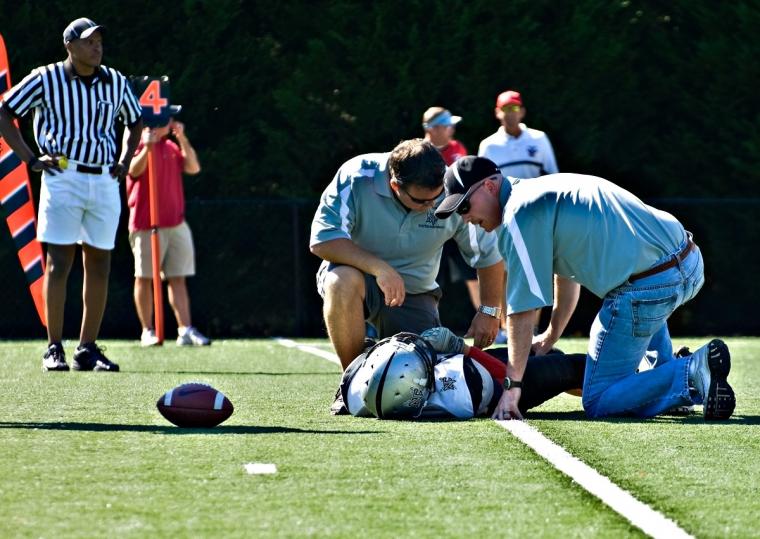

While concussions have been sidelined from the nation’s consciousness since 2020, research on them has continued. But with news of an enormous grant to the NCAA-U.S. Department of Defense Concussion Assessment, Research and Education (CARE) Consortium, they are very much back in the news.
The largest concussion and repetitive head impact study in history recently received a $25 million award from the Medical Technology Enterprise Consortium (MTEC) via the U.S. Army Medical Research and Development Command (USAMRDC). The funding is from the Defense Health Program under the oversight of the assistant secretary of defense for health affairs.
An additional $10 million from the NCAA and $7.65 million from the Defense Health Agency via a Cooperative Research and Development Agreement will provide funding to begin the next phase of this massive research project that began in 2014.
Total funding for the project now tops $105 million.
According to the NCAA:
This next phase of CARE, known as the CARE/Service Academy Longitudinal mTBI Outcomes Study (SALTOS) Integrated (CSI) Study, will investigate the nature and causes of long-term effects of head impact exposure (HIE) and concussion/mild traumatic brain injury in NCAA student-athletes and military service members.
The newly awarded funding from MTEC/DoD and the NCAA provides the CSI Study investigative team additional resources to build upon existing CARE/SALTOS research by following former CARE research participants beyond graduation to evaluate the long-term or late effects of HIE and/or concussion/mTBI for up to 10 years or more after initial exposure or injury.
“Identifying the neurobiological pathways that possibly contribute to long-term negative consequences of concussion and repetitive head impacts is critical for the development of early interventions and strategies in athletes … who are at risk,” NCAA Chief Medical Officer Dr. Brian Hainline said in a statement. “We are confident this award from MTEC, coupled with additional funding from the NCAA and DoD, will provide us the support to develop an array of interventions that might mitigate possible long-term effects of concussion or HIE.”
In other concussion-related news:
University of Florida Health researchers have determined that female high school lacrosse players are significantly less likely to sustain concussions if they wear headgear. The topic of whether players should wear headgear has been one of intense debate in recent years. But, as University of Florida Health notes, “girls who play the sport in states that don’t require headgear had a 59% higher concussion rate than players in Florida, the only state with a headgear mandate. The researchers also found lacrosse games were more hazardous than practices: Concussions were 74% higher during competition among players in states without headgear requirements when compared with Florida players.” Data for the study was collected during 357,225 games and practices in Florida and other states during three seasons from 2018 to 2021. (Boys’ lacrosse is considered a contact sport, and players are required to wear helmets; conversely, stick-to-stick is the only contact permitted in girls’ lacrosse.)
The National Institute of Neurological Disorders and Stroke has awarded a $10 million grant to the Four Corners Youth Consortium, a group of organizations researching concussions in children ages 11 to 17. Researchers will study biological markers such as brain imaging scans, blood tests, and changes in blood pressure and heart rate — potential predictors of which children might be at higher risk for developing persistent post-concussion symptoms. More than 1,3000 children nationally are expected to be involved in the study. Participating institutions include Seattle Children’s, the University of Washington School of Medicine, UCLA, Children’s National Hospital, the University of Texas Southwestern Medical Center, Wake Forest University, the University of Rochester, and the data-coordinating center at the University of Utah.
Researchers at the University at Buffalo’s Concussion Management Clinic have developed a 10-minute standardized physical exam for sport-related concussive brain injuries in children and adolescents that can readily identify who is at risk for persistent post-concussion symptoms (PPCS). The Buffalo Concussion Physical Examination’s Risk of Delayed Recovery (RDR) score is the first decision rule to help clinicians who aren’t concussion specialists quickly identify which children are at risk for PPCS within 10 days of injury and should be referred to a specialist for focused treatment. A decision rule is an evidence-based tool that helps clinicians make diagnostic and therapeutic decisions. In this case, according to University at Buffalo officials, the decision rule correctly identified who would go on to develop PPCS in 85% of cases. Plans call for the development of an app that can generate an on-site RDR score, researchers say.

